Managing Change Report: Analyzing Cargill's Project Obstacles
VerifiedAdded on 2019/10/30
|6
|1495
|152
Report
AI Summary
This report examines the challenges of managing change, focusing on the obstacles Cargill's board faces in implementing a climate change project affecting the farming community. The report identifies several barriers: perception, cultural resistance, environmental obstructions, cognitive limitations due to incomplete information, and emotional barriers within the workforce. The farming community's perception that agriculture isn't the primary cause of climate change, combined with their cultural ties to traditional farming practices, fuels resistance. Environmental factors, such as trade unions, and cognitive barriers stemming from the lack of certainty regarding project success further complicate the process. Finally, emotional barriers within Cargill's workforce, including risk aversion and ties to the farming community, impede the ability to generate solutions. The report emphasizes the need for a strategic approach to overcome these hurdles and ensure successful implementation. The report highlights the importance of addressing resistance to change and the need for a comprehensive approach that considers internal and external factors.
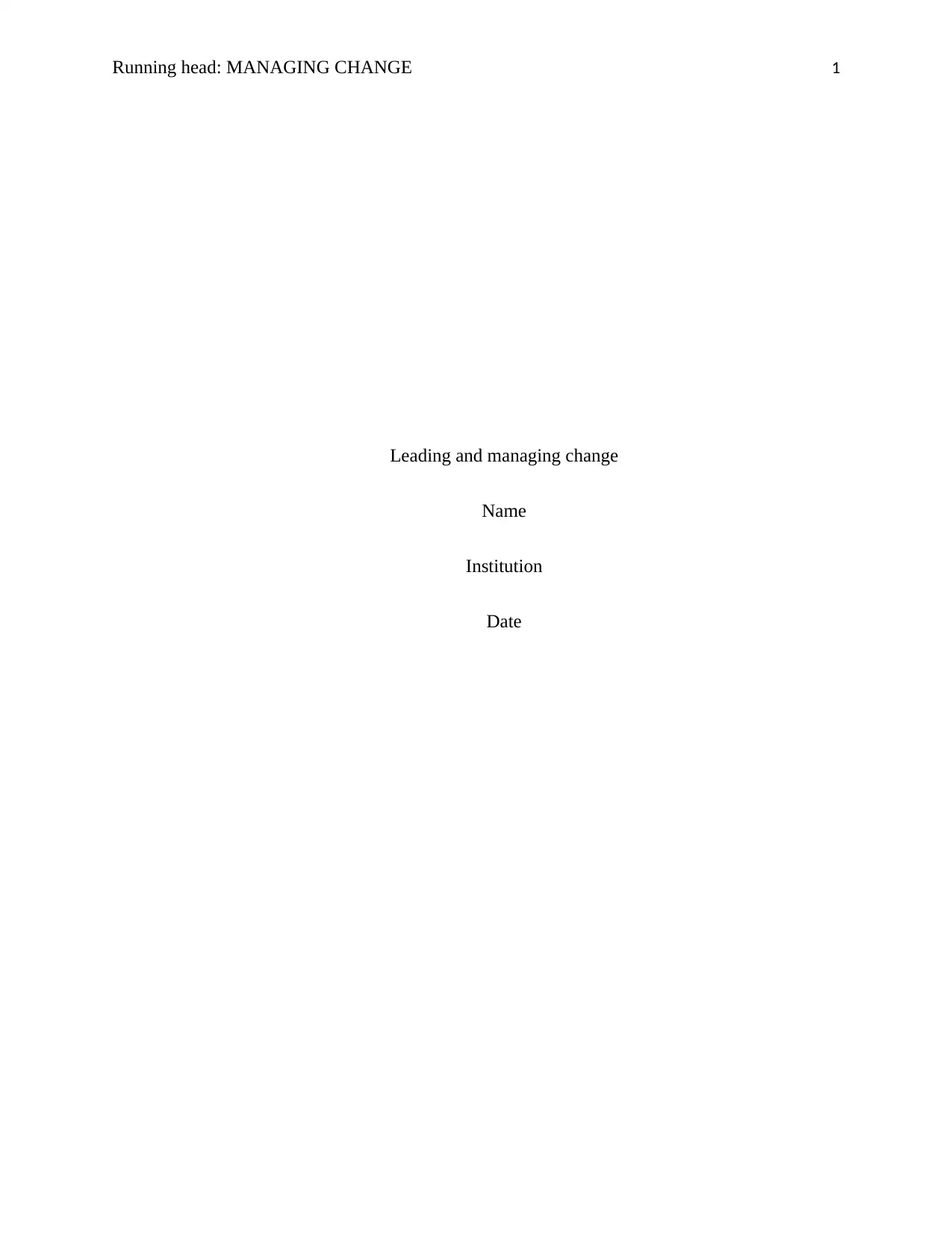
Running head: MANAGING CHANGE 1
Leading and managing change
Name
Institution
Date
Leading and managing change
Name
Institution
Date
Paraphrase This Document
Need a fresh take? Get an instant paraphrase of this document with our AI Paraphraser
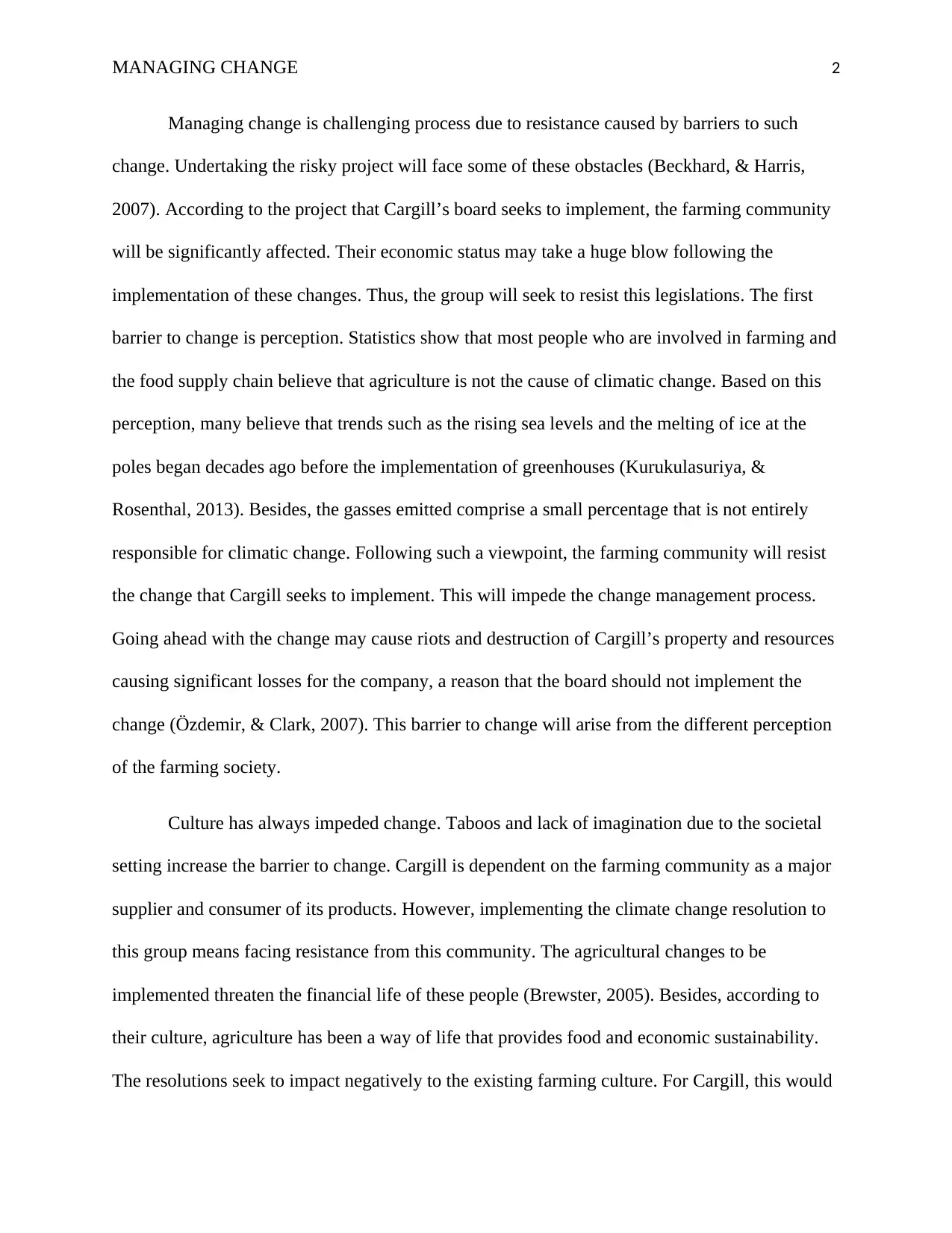
MANAGING CHANGE 2
Managing change is challenging process due to resistance caused by barriers to such
change. Undertaking the risky project will face some of these obstacles (Beckhard, & Harris,
2007). According to the project that Cargill’s board seeks to implement, the farming community
will be significantly affected. Their economic status may take a huge blow following the
implementation of these changes. Thus, the group will seek to resist this legislations. The first
barrier to change is perception. Statistics show that most people who are involved in farming and
the food supply chain believe that agriculture is not the cause of climatic change. Based on this
perception, many believe that trends such as the rising sea levels and the melting of ice at the
poles began decades ago before the implementation of greenhouses (Kurukulasuriya, &
Rosenthal, 2013). Besides, the gasses emitted comprise a small percentage that is not entirely
responsible for climatic change. Following such a viewpoint, the farming community will resist
the change that Cargill seeks to implement. This will impede the change management process.
Going ahead with the change may cause riots and destruction of Cargill’s property and resources
causing significant losses for the company, a reason that the board should not implement the
change (Özdemir, & Clark, 2007). This barrier to change will arise from the different perception
of the farming society.
Culture has always impeded change. Taboos and lack of imagination due to the societal
setting increase the barrier to change. Cargill is dependent on the farming community as a major
supplier and consumer of its products. However, implementing the climate change resolution to
this group means facing resistance from this community. The agricultural changes to be
implemented threaten the financial life of these people (Brewster, 2005). Besides, according to
their culture, agriculture has been a way of life that provides food and economic sustainability.
The resolutions seek to impact negatively to the existing farming culture. For Cargill, this would
Managing change is challenging process due to resistance caused by barriers to such
change. Undertaking the risky project will face some of these obstacles (Beckhard, & Harris,
2007). According to the project that Cargill’s board seeks to implement, the farming community
will be significantly affected. Their economic status may take a huge blow following the
implementation of these changes. Thus, the group will seek to resist this legislations. The first
barrier to change is perception. Statistics show that most people who are involved in farming and
the food supply chain believe that agriculture is not the cause of climatic change. Based on this
perception, many believe that trends such as the rising sea levels and the melting of ice at the
poles began decades ago before the implementation of greenhouses (Kurukulasuriya, &
Rosenthal, 2013). Besides, the gasses emitted comprise a small percentage that is not entirely
responsible for climatic change. Following such a viewpoint, the farming community will resist
the change that Cargill seeks to implement. This will impede the change management process.
Going ahead with the change may cause riots and destruction of Cargill’s property and resources
causing significant losses for the company, a reason that the board should not implement the
change (Özdemir, & Clark, 2007). This barrier to change will arise from the different perception
of the farming society.
Culture has always impeded change. Taboos and lack of imagination due to the societal
setting increase the barrier to change. Cargill is dependent on the farming community as a major
supplier and consumer of its products. However, implementing the climate change resolution to
this group means facing resistance from this community. The agricultural changes to be
implemented threaten the financial life of these people (Brewster, 2005). Besides, according to
their culture, agriculture has been a way of life that provides food and economic sustainability.
The resolutions seek to impact negatively to the existing farming culture. For Cargill, this would
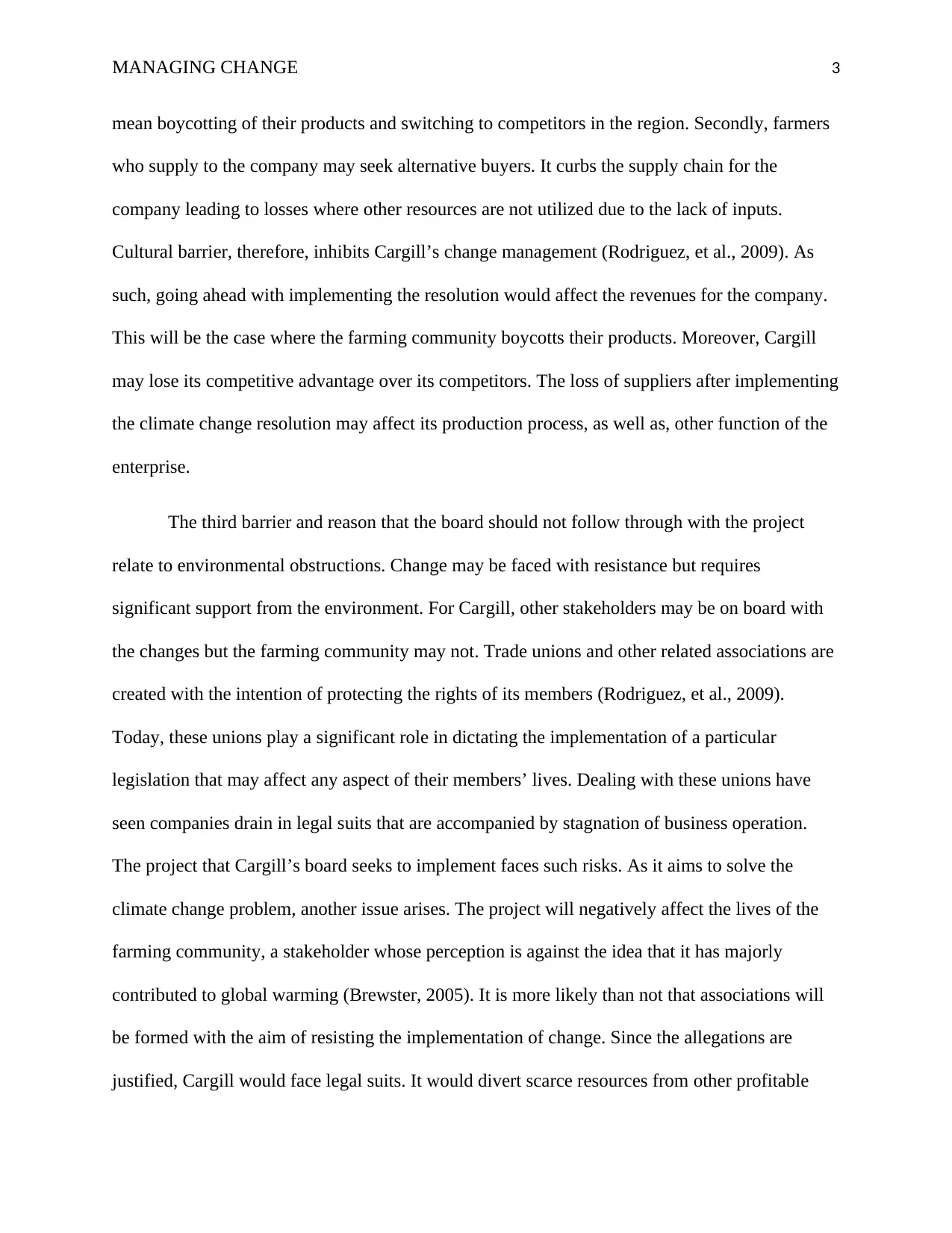
MANAGING CHANGE 3
mean boycotting of their products and switching to competitors in the region. Secondly, farmers
who supply to the company may seek alternative buyers. It curbs the supply chain for the
company leading to losses where other resources are not utilized due to the lack of inputs.
Cultural barrier, therefore, inhibits Cargill’s change management (Rodriguez, et al., 2009). As
such, going ahead with implementing the resolution would affect the revenues for the company.
This will be the case where the farming community boycotts their products. Moreover, Cargill
may lose its competitive advantage over its competitors. The loss of suppliers after implementing
the climate change resolution may affect its production process, as well as, other function of the
enterprise.
The third barrier and reason that the board should not follow through with the project
relate to environmental obstructions. Change may be faced with resistance but requires
significant support from the environment. For Cargill, other stakeholders may be on board with
the changes but the farming community may not. Trade unions and other related associations are
created with the intention of protecting the rights of its members (Rodriguez, et al., 2009).
Today, these unions play a significant role in dictating the implementation of a particular
legislation that may affect any aspect of their members’ lives. Dealing with these unions have
seen companies drain in legal suits that are accompanied by stagnation of business operation.
The project that Cargill’s board seeks to implement faces such risks. As it aims to solve the
climate change problem, another issue arises. The project will negatively affect the lives of the
farming community, a stakeholder whose perception is against the idea that it has majorly
contributed to global warming (Brewster, 2005). It is more likely than not that associations will
be formed with the aim of resisting the implementation of change. Since the allegations are
justified, Cargill would face legal suits. It would divert scarce resources from other profitable
mean boycotting of their products and switching to competitors in the region. Secondly, farmers
who supply to the company may seek alternative buyers. It curbs the supply chain for the
company leading to losses where other resources are not utilized due to the lack of inputs.
Cultural barrier, therefore, inhibits Cargill’s change management (Rodriguez, et al., 2009). As
such, going ahead with implementing the resolution would affect the revenues for the company.
This will be the case where the farming community boycotts their products. Moreover, Cargill
may lose its competitive advantage over its competitors. The loss of suppliers after implementing
the climate change resolution may affect its production process, as well as, other function of the
enterprise.
The third barrier and reason that the board should not follow through with the project
relate to environmental obstructions. Change may be faced with resistance but requires
significant support from the environment. For Cargill, other stakeholders may be on board with
the changes but the farming community may not. Trade unions and other related associations are
created with the intention of protecting the rights of its members (Rodriguez, et al., 2009).
Today, these unions play a significant role in dictating the implementation of a particular
legislation that may affect any aspect of their members’ lives. Dealing with these unions have
seen companies drain in legal suits that are accompanied by stagnation of business operation.
The project that Cargill’s board seeks to implement faces such risks. As it aims to solve the
climate change problem, another issue arises. The project will negatively affect the lives of the
farming community, a stakeholder whose perception is against the idea that it has majorly
contributed to global warming (Brewster, 2005). It is more likely than not that associations will
be formed with the aim of resisting the implementation of change. Since the allegations are
justified, Cargill would face legal suits. It would divert scarce resources from other profitable
⊘ This is a preview!⊘
Do you want full access?
Subscribe today to unlock all pages.

Trusted by 1+ million students worldwide
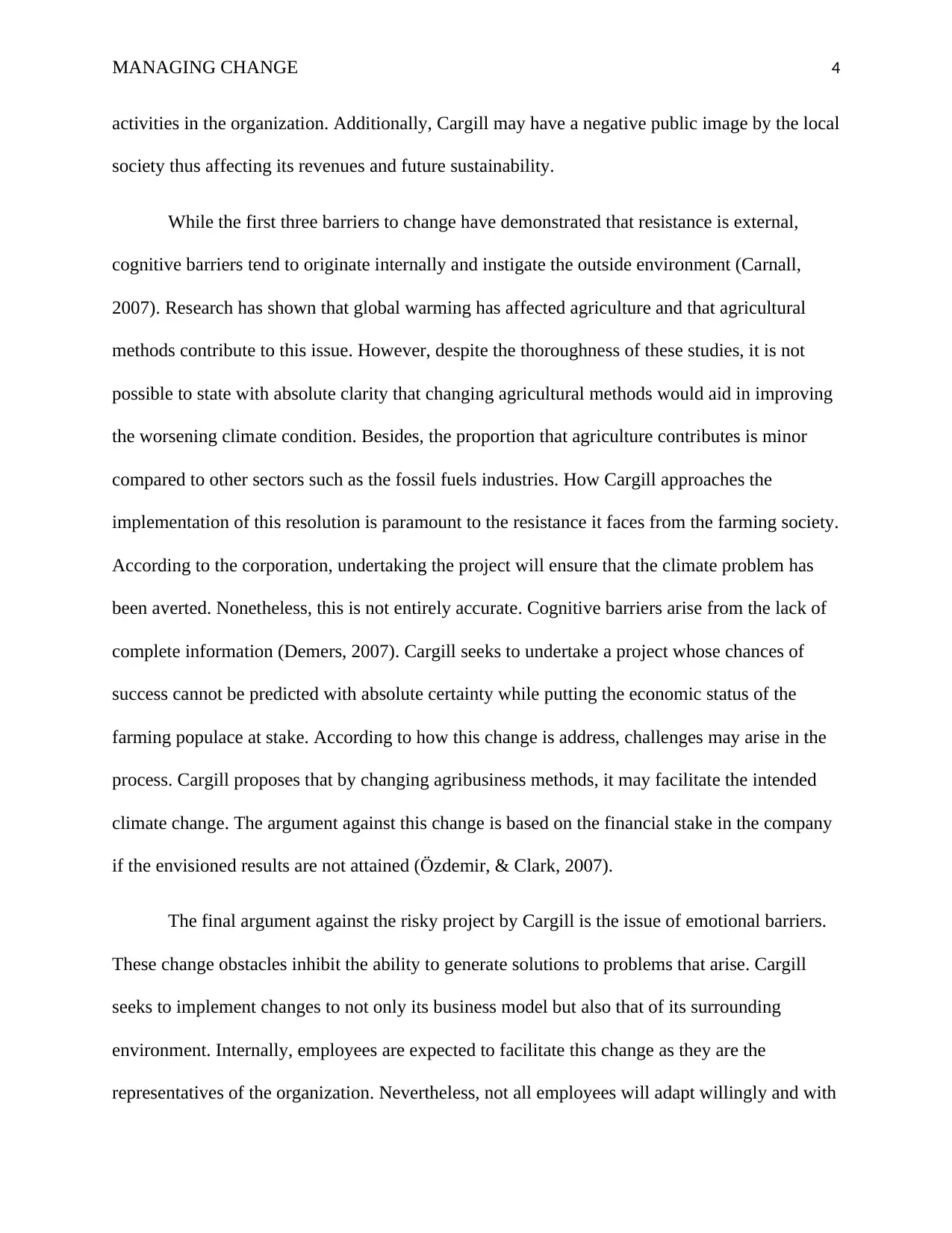
MANAGING CHANGE 4
activities in the organization. Additionally, Cargill may have a negative public image by the local
society thus affecting its revenues and future sustainability.
While the first three barriers to change have demonstrated that resistance is external,
cognitive barriers tend to originate internally and instigate the outside environment (Carnall,
2007). Research has shown that global warming has affected agriculture and that agricultural
methods contribute to this issue. However, despite the thoroughness of these studies, it is not
possible to state with absolute clarity that changing agricultural methods would aid in improving
the worsening climate condition. Besides, the proportion that agriculture contributes is minor
compared to other sectors such as the fossil fuels industries. How Cargill approaches the
implementation of this resolution is paramount to the resistance it faces from the farming society.
According to the corporation, undertaking the project will ensure that the climate problem has
been averted. Nonetheless, this is not entirely accurate. Cognitive barriers arise from the lack of
complete information (Demers, 2007). Cargill seeks to undertake a project whose chances of
success cannot be predicted with absolute certainty while putting the economic status of the
farming populace at stake. According to how this change is address, challenges may arise in the
process. Cargill proposes that by changing agribusiness methods, it may facilitate the intended
climate change. The argument against this change is based on the financial stake in the company
if the envisioned results are not attained (Özdemir, & Clark, 2007).
The final argument against the risky project by Cargill is the issue of emotional barriers.
These change obstacles inhibit the ability to generate solutions to problems that arise. Cargill
seeks to implement changes to not only its business model but also that of its surrounding
environment. Internally, employees are expected to facilitate this change as they are the
representatives of the organization. Nevertheless, not all employees will adapt willingly and with
activities in the organization. Additionally, Cargill may have a negative public image by the local
society thus affecting its revenues and future sustainability.
While the first three barriers to change have demonstrated that resistance is external,
cognitive barriers tend to originate internally and instigate the outside environment (Carnall,
2007). Research has shown that global warming has affected agriculture and that agricultural
methods contribute to this issue. However, despite the thoroughness of these studies, it is not
possible to state with absolute clarity that changing agricultural methods would aid in improving
the worsening climate condition. Besides, the proportion that agriculture contributes is minor
compared to other sectors such as the fossil fuels industries. How Cargill approaches the
implementation of this resolution is paramount to the resistance it faces from the farming society.
According to the corporation, undertaking the project will ensure that the climate problem has
been averted. Nonetheless, this is not entirely accurate. Cognitive barriers arise from the lack of
complete information (Demers, 2007). Cargill seeks to undertake a project whose chances of
success cannot be predicted with absolute certainty while putting the economic status of the
farming populace at stake. According to how this change is address, challenges may arise in the
process. Cargill proposes that by changing agribusiness methods, it may facilitate the intended
climate change. The argument against this change is based on the financial stake in the company
if the envisioned results are not attained (Özdemir, & Clark, 2007).
The final argument against the risky project by Cargill is the issue of emotional barriers.
These change obstacles inhibit the ability to generate solutions to problems that arise. Cargill
seeks to implement changes to not only its business model but also that of its surrounding
environment. Internally, employees are expected to facilitate this change as they are the
representatives of the organization. Nevertheless, not all employees will adapt willingly and with
Paraphrase This Document
Need a fresh take? Get an instant paraphrase of this document with our AI Paraphraser
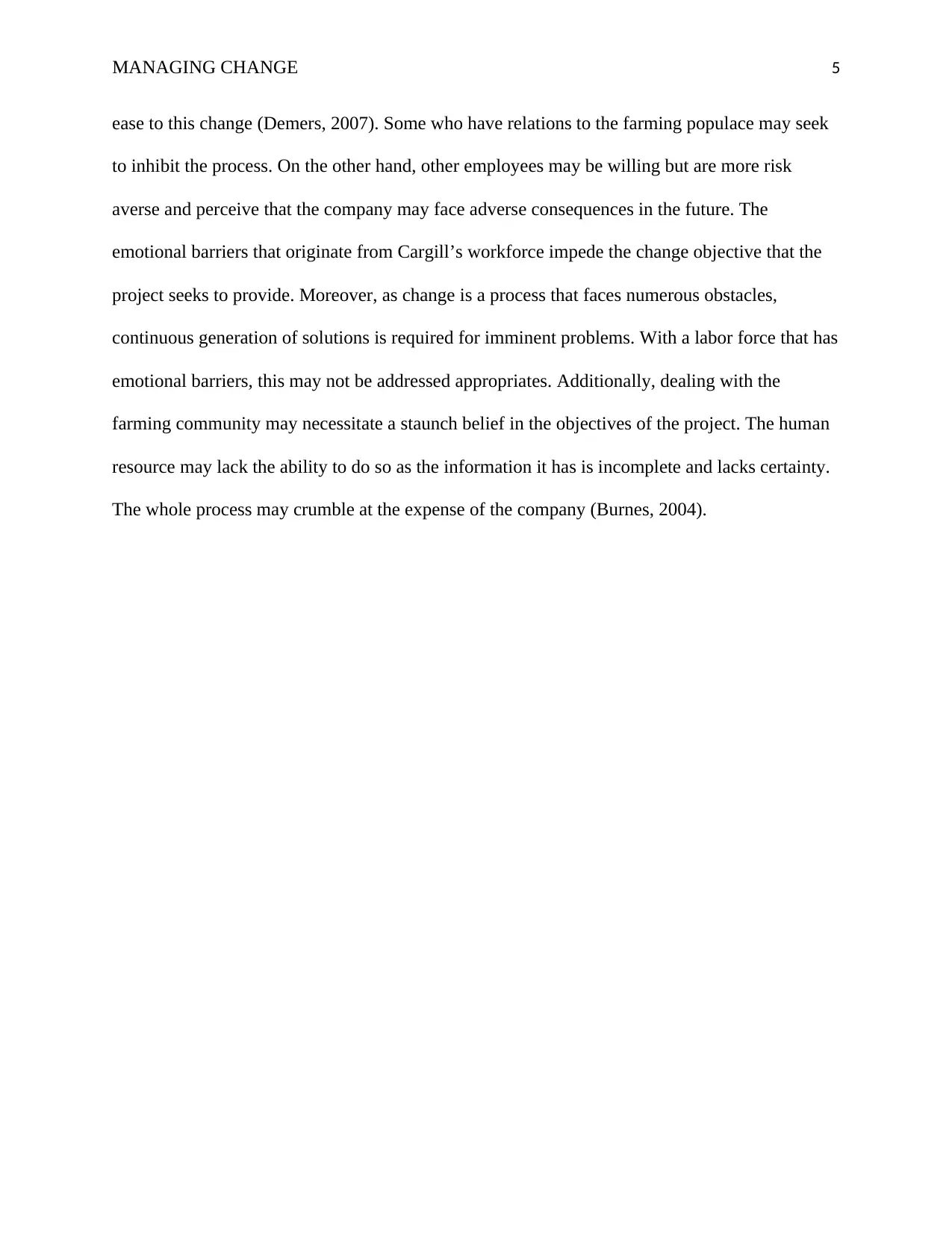
MANAGING CHANGE 5
ease to this change (Demers, 2007). Some who have relations to the farming populace may seek
to inhibit the process. On the other hand, other employees may be willing but are more risk
averse and perceive that the company may face adverse consequences in the future. The
emotional barriers that originate from Cargill’s workforce impede the change objective that the
project seeks to provide. Moreover, as change is a process that faces numerous obstacles,
continuous generation of solutions is required for imminent problems. With a labor force that has
emotional barriers, this may not be addressed appropriates. Additionally, dealing with the
farming community may necessitate a staunch belief in the objectives of the project. The human
resource may lack the ability to do so as the information it has is incomplete and lacks certainty.
The whole process may crumble at the expense of the company (Burnes, 2004).
ease to this change (Demers, 2007). Some who have relations to the farming populace may seek
to inhibit the process. On the other hand, other employees may be willing but are more risk
averse and perceive that the company may face adverse consequences in the future. The
emotional barriers that originate from Cargill’s workforce impede the change objective that the
project seeks to provide. Moreover, as change is a process that faces numerous obstacles,
continuous generation of solutions is required for imminent problems. With a labor force that has
emotional barriers, this may not be addressed appropriates. Additionally, dealing with the
farming community may necessitate a staunch belief in the objectives of the project. The human
resource may lack the ability to do so as the information it has is incomplete and lacks certainty.
The whole process may crumble at the expense of the company (Burnes, 2004).
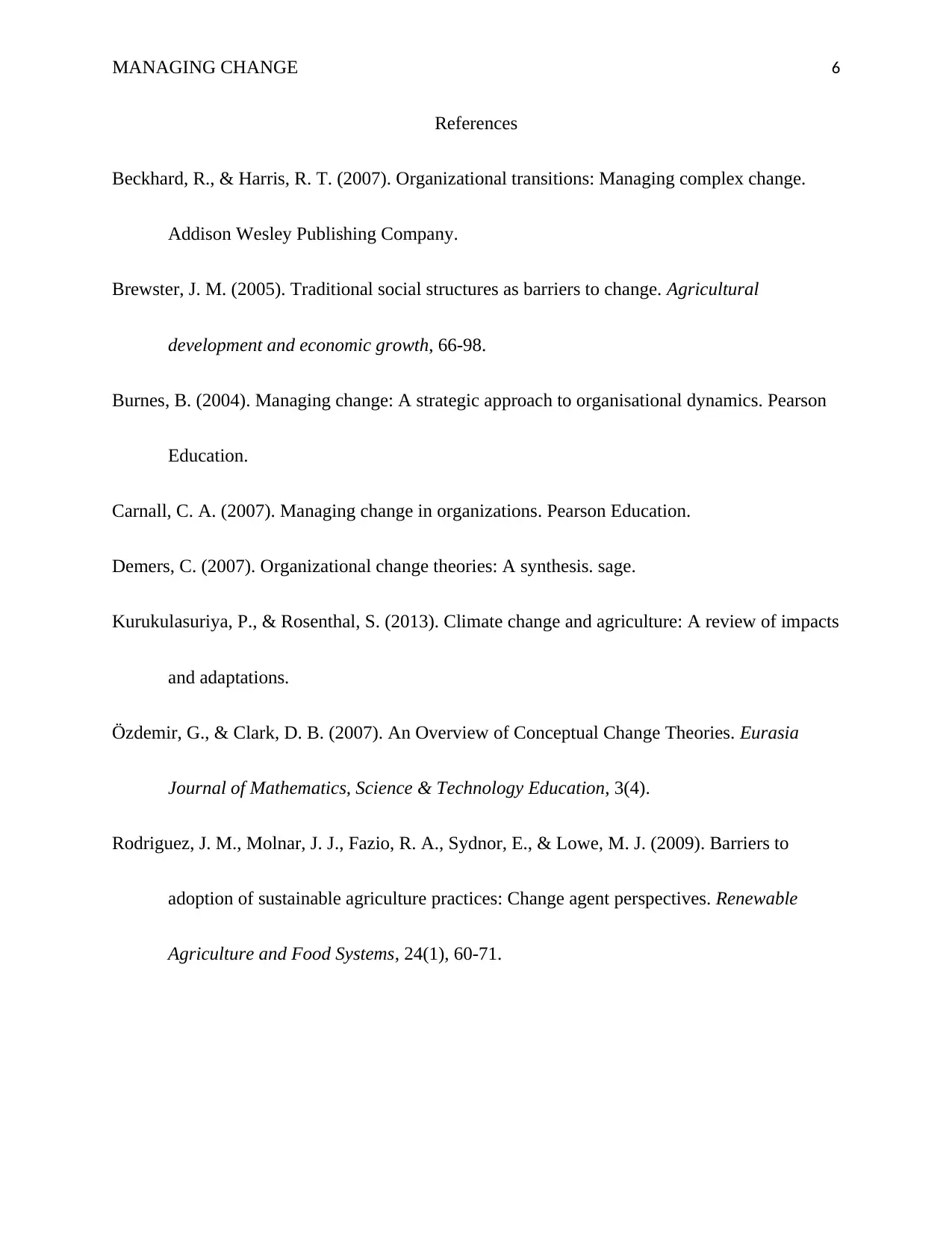
MANAGING CHANGE 6
References
Beckhard, R., & Harris, R. T. (2007). Organizational transitions: Managing complex change.
Addison Wesley Publishing Company.
Brewster, J. M. (2005). Traditional social structures as barriers to change. Agricultural
development and economic growth, 66-98.
Burnes, B. (2004). Managing change: A strategic approach to organisational dynamics. Pearson
Education.
Carnall, C. A. (2007). Managing change in organizations. Pearson Education.
Demers, C. (2007). Organizational change theories: A synthesis. sage.
Kurukulasuriya, P., & Rosenthal, S. (2013). Climate change and agriculture: A review of impacts
and adaptations.
Özdemir, G., & Clark, D. B. (2007). An Overview of Conceptual Change Theories. Eurasia
Journal of Mathematics, Science & Technology Education, 3(4).
Rodriguez, J. M., Molnar, J. J., Fazio, R. A., Sydnor, E., & Lowe, M. J. (2009). Barriers to
adoption of sustainable agriculture practices: Change agent perspectives. Renewable
Agriculture and Food Systems, 24(1), 60-71.
References
Beckhard, R., & Harris, R. T. (2007). Organizational transitions: Managing complex change.
Addison Wesley Publishing Company.
Brewster, J. M. (2005). Traditional social structures as barriers to change. Agricultural
development and economic growth, 66-98.
Burnes, B. (2004). Managing change: A strategic approach to organisational dynamics. Pearson
Education.
Carnall, C. A. (2007). Managing change in organizations. Pearson Education.
Demers, C. (2007). Organizational change theories: A synthesis. sage.
Kurukulasuriya, P., & Rosenthal, S. (2013). Climate change and agriculture: A review of impacts
and adaptations.
Özdemir, G., & Clark, D. B. (2007). An Overview of Conceptual Change Theories. Eurasia
Journal of Mathematics, Science & Technology Education, 3(4).
Rodriguez, J. M., Molnar, J. J., Fazio, R. A., Sydnor, E., & Lowe, M. J. (2009). Barriers to
adoption of sustainable agriculture practices: Change agent perspectives. Renewable
Agriculture and Food Systems, 24(1), 60-71.
⊘ This is a preview!⊘
Do you want full access?
Subscribe today to unlock all pages.

Trusted by 1+ million students worldwide
1 out of 6
Your All-in-One AI-Powered Toolkit for Academic Success.
+13062052269
info@desklib.com
Available 24*7 on WhatsApp / Email
![[object Object]](/_next/static/media/star-bottom.7253800d.svg)
Unlock your academic potential
Copyright © 2020–2025 A2Z Services. All Rights Reserved. Developed and managed by ZUCOL.